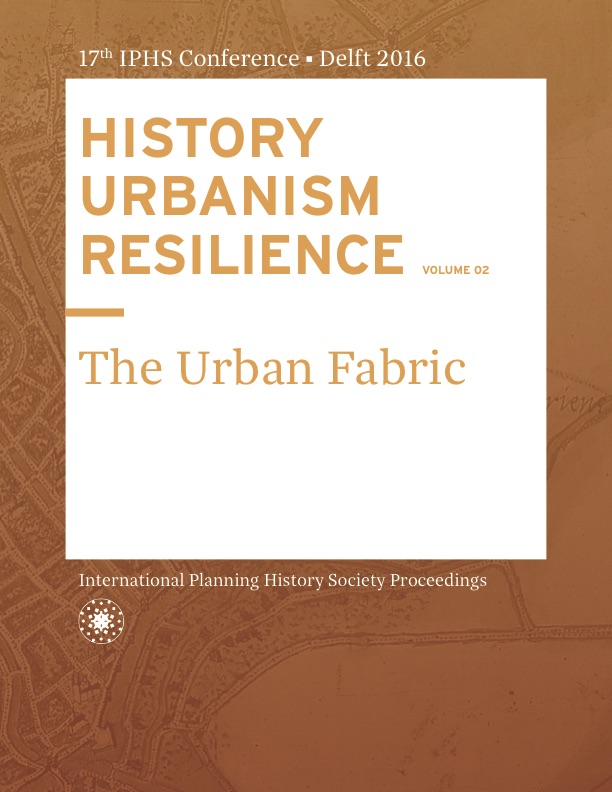Insurgent Urbanism: alternative modes of production and appropriation of urban space in the outskirts of Sao Paulo
DOI:
https://doi.org/10.7480/iphs.2016.2.1241Abstract
This paper presents a research on new forms of appropriation of public space through actions that are self-managed and crosscutting to government arrangements, led by decentralized groups, organized so anarchic and horizontal, flexible and situational, which has been called in Brazil as "urban collectives". Because of theirs critical stance to the status quo and limiting forms of access to urban, these groups propose alternative ways to use, look, plan, discuss, build and inhabit the city, we call: insurgent urbanism. Therefore, this paper seeks to understand the appropriation of public spaces by these groups in the outskirts of Sao Paulo, on the margins of large investments primarily cultural. We presents some mapping of these groups and their actions in the North, East and South zones of the city, which have significant and increasing number of micro urban interventions with strong political character, but which are still not known because they are off-axis "center - west", recognized as a creativity axis. In these periphery areas, the key element is the functionality and the potential for organization to fight, argue and claim for public policy for the communities of the suburbs. The aim is to understand its legitimacy as a social organization, and the public sphere concepts tied to the emergence of these groups in Brazil. By mapping the alternatives that has been made in these areas, one can compare them with the actions developed in the most valued areas of the city, identifying conceptual approaches and significant differences in these actions. The historical context in which the "urban collectives" arised in Brazil is from the 1990s, in a productive post-restructuring period, which resulted in the deepening socio-spatial inequalities in São Paulo. Also during this period, the construction of shopping malls and gated communities grew; there was the spread of the culture of fear, with expansion of buildings with prison walls, private security and traffic controls, fragmenting the city and aggravating inequality between extremes of the population. At this time, the excluded population manifests itself, creating a real "civil war for places", ie a clash between the city "militarized" versus the resumption of public space by the population, especially through cultural movements in the periphery. The popular uprisings, spontaneous interventions or ephemeral architectures, ie, micro urban interventions represent demands and emergencies, with the motto citizens as key player in the city's production. Network communication and increased access to information influence largely social organizations from that time, becoming the main tool used by the collectives for their articulation. One should note that the forms of collective action currently differ from those of the last century, trade unions, for example. Self-managed, decentralized, with horizontal hierarchical, allowing certain nomadism, they use short-term and tactical actions, to reach long-term changes. Thus, this research aims to provide conclusive data not only for the understanding of these experiences in the peripheral areas of São Paulo, but mainly to provide support to the urbanist generates solutions that really meet the demand of the population, respecting cultural differences of each region.References
Caldeira, Teresa P. do Rio. Cidade de Muros: Crime, Segregação e Cidadania em São Paulo. São Paulo: Editora 34/Edusp, 2000.
Castells, Manuel. A sociedade em rede. São Paulo: ed. Paz e Terra, 1999. v. 1.
Deleuze, Gilles; Guattari, Félix. Mil Platôs: Capitalismo e Esquizofrenia. Rio de Janeiro: Ed. 34, 1996, v. 1.
Gehl, Jan. Cidades para pessoas. São Paulo: Perspectiva, 2013.
Grostein, Marta Dora. Metrópole e expansão urbana: a persistência de processos “insustentáveis”. São Paulo: Perspectiva, vol.15 no.1, 2001.
Harvey, David. Condição pós moderna. São Paulo: ed. Loyola, 2003.
Holanda, Frederico. Arquitetura e urbanidade. São Paulo: ProEditores Associados, 2003.
Jacobs, Jane. Morte e vida de grandes cidades. São Paulo: Martins Fontes, 2000.
Lyndon, Mike; Garcia, Anthony. Tactical Urbanism: short-term action for long-term change. London: Island press, 2015.
Maziviero, Maria Carolina. Plus d’un siècle de privatisme dans la gestion urbaine de Santos. In: Métropoles des Amériques en Mutation, edited by Luc-Normand Tellier, p. 305-316. Montral: Presses de l’Université du Québec, 2012.
Negri, Antonio, and Michael Hardt. Multitão: Guerra e Democracia na Era do Império. Rio de Janeiro: ed.Record, 2005.
Negri, Antonio. É a multidão que comanda a história. In: Jornal Zero Hora, Caderno Proa, 2014. Accessed in: March 15, 2016, http://zh.clicrbs.com.br/rs/noticias/proa/noticia/2014/06/antonio-negri-e-a-multidao-que-comanda-a-historia-4520222.html
Sennett, Richard. O Declínio do Homem Público: as tiranias da intimidade. São Paulo: Companhia das Letras, 1999.

